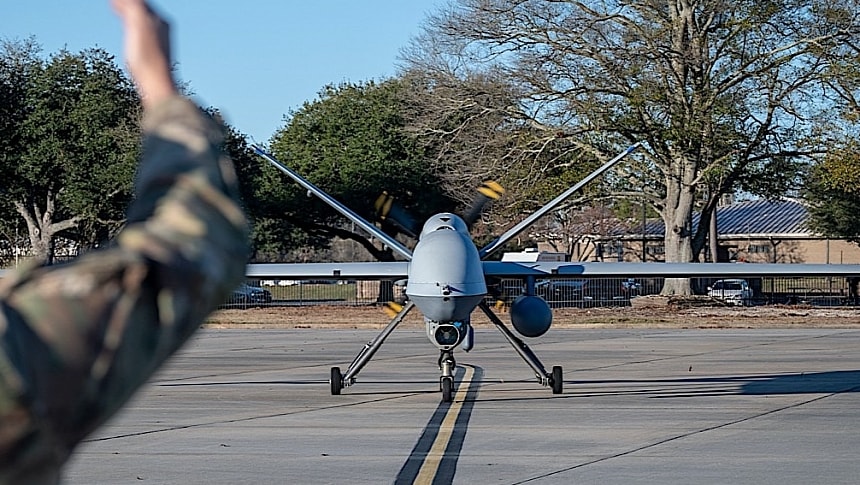Despite a lot of them being in the sky at the time of writing, no military drone is actually fully autonomous. Regardless of its size, type, and use, every drone currently flying has a human somewhere telling it what to do. And so does one of the most potent uncrewed aerial weapons platforms, the mighty General Atomics MQ-9 Reaper.
The drone has been around and in the service of the American military for over two decades now, with over 300 of them made since its introduction. Each one generally needs a crew of two people sitting in a ground station somewhere and directing its takeoff, flight, and landing.
At least that was how things used to be, as the U.S. is slowly transitioning to making the Reaper's most dangerous flight stages dependent on satellite control.
Technically speaking, any Reaper out there already relies on a primary satellite link, tied to a series of sensors and the ground control station to do its thing, and are using them all during missions. When it comes to a critical stage in the drone's operation, the landing, the USAF prefered until now a more direct approach.
That is slowly changing, as satellite control of landings is becoming the norm in the MQ-9 community, as per the U.S. Air Force (USAF). That is done in a bid to "replace legacy processes requiring additional ground control stations, aircrews, and maintenance support."
A historic first, as the USAF calls it, took place at the Shaw Air Force Base in South Carolina, where on Valentine's Day a Reaper landed completely under satellite control. The operation was conducted by the airmen of the 50th Attack Squadron and 163rd Attack Wing and was the "culmination of a month-long effort."
It's unclear at this point how widespread this way of doing things will become, and how fast, but it will likely make this particular drone even more fit for the dangerous missions it is usually assigned with.
Technically designed for intelligence, surveillance, and reconnaissance (ISR) missions, the Reaper does not shy away from engaging enemies from afar. No less than seven hard points allow the attaching of a variety of weapons, ranging from Hellfire missiles to JDAMs.
The Reaper can stay airborne for up to 34 hours (the extended-range variant) and can reach altitudes of up to 50,000 feet (15 km).
Just to give you a sense of how important these machines are to America's efforts of protecting itself I'll remind you that at the end of 2022 the breed surpassed two million flight hours. We haven't received any update on that front since, but it's likely a lot more hours spent on secret flights have been added in the almost two years that have passed.
At least that was how things used to be, as the U.S. is slowly transitioning to making the Reaper's most dangerous flight stages dependent on satellite control.
Technically speaking, any Reaper out there already relies on a primary satellite link, tied to a series of sensors and the ground control station to do its thing, and are using them all during missions. When it comes to a critical stage in the drone's operation, the landing, the USAF prefered until now a more direct approach.
That is slowly changing, as satellite control of landings is becoming the norm in the MQ-9 community, as per the U.S. Air Force (USAF). That is done in a bid to "replace legacy processes requiring additional ground control stations, aircrews, and maintenance support."
A historic first, as the USAF calls it, took place at the Shaw Air Force Base in South Carolina, where on Valentine's Day a Reaper landed completely under satellite control. The operation was conducted by the airmen of the 50th Attack Squadron and 163rd Attack Wing and was the "culmination of a month-long effort."
It's unclear at this point how widespread this way of doing things will become, and how fast, but it will likely make this particular drone even more fit for the dangerous missions it is usually assigned with.
Technically designed for intelligence, surveillance, and reconnaissance (ISR) missions, the Reaper does not shy away from engaging enemies from afar. No less than seven hard points allow the attaching of a variety of weapons, ranging from Hellfire missiles to JDAMs.
The Reaper can stay airborne for up to 34 hours (the extended-range variant) and can reach altitudes of up to 50,000 feet (15 km).
Just to give you a sense of how important these machines are to America's efforts of protecting itself I'll remind you that at the end of 2022 the breed surpassed two million flight hours. We haven't received any update on that front since, but it's likely a lot more hours spent on secret flights have been added in the almost two years that have passed.












